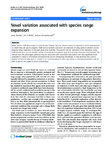Novel variation associated with species range expansion
| dc.contributor.author | Buckley, James | |
| dc.contributor.author | Bridle, JR | |
| dc.contributor.author | Pomiankowski, A | |
| dc.date.accessioned | 2020-09-15T08:22:32Z | |
| dc.date.available | 2020-09-15T08:22:32Z | |
| dc.date.issued | 2010-12 | |
| dc.identifier.issn | 1471-2148 | |
| dc.identifier.issn | 1471-2148 | |
| dc.identifier.other | 382 | |
| dc.identifier.uri | http://hdl.handle.net/10026.1/16282 | |
| dc.description.abstract |
<jats:title>Abstract</jats:title> <jats:p>When species shift their ranges to track climate change, they are almost certain to experience novel environments to which they are poorly adapted. Otaki and co-workers document an explosion of wing pattern variation accompanying range expansion in the pale grass blue butterfly. This pattern can be replicated in the laboratory using artificial selection on cold shocked pupae, at temperature extremes typical of recently colonized environments. We discuss how this phenotypic plasticity may be associated with successful colonization and how significant local adaptation is likely to re-establish developmental control. Integrating knowledge of trait plasticity into current genetic models of adaptation is central to our understanding of when and where a colonising population will be able to persist and adapt in novel surroundings.</jats:p> | |
| dc.format.extent | 382- | |
| dc.format.medium | Electronic | |
| dc.language | en | |
| dc.language.iso | eng | |
| dc.publisher | Springer Science and Business Media LLC | |
| dc.subject | Adaptation, Biological | |
| dc.subject | Animals | |
| dc.subject | Butterflies | |
| dc.subject | Climate Change | |
| dc.subject | Environment | |
| dc.subject | Evolution, Molecular | |
| dc.subject | Larva | |
| dc.subject | Phenotype | |
| dc.subject | Selection, Genetic | |
| dc.subject | Temperature | |
| dc.subject | Wings, Animal | |
| dc.title | Novel variation associated with species range expansion | |
| dc.type | journal-article | |
| dc.type | Comment | |
| dc.type | Journal Article | |
| plymouth.author-url | https://www.webofscience.com/api/gateway?GWVersion=2&SrcApp=PARTNER_APP&SrcAuth=LinksAMR&KeyUT=WOS:000287576900002&DestLinkType=FullRecord&DestApp=ALL_WOS&UsrCustomerID=11bb513d99f797142bcfeffcc58ea008 | |
| plymouth.issue | 1 | |
| plymouth.volume | 10 | |
| plymouth.publication-status | Published | |
| plymouth.journal | BMC Evolutionary Biology | |
| dc.identifier.doi | 10.1186/1471-2148-10-382 | |
| plymouth.organisational-group | /Plymouth | |
| plymouth.organisational-group | /Plymouth/Faculty of Science and Engineering | |
| plymouth.organisational-group | /Plymouth/Faculty of Science and Engineering/School of Biological and Marine Sciences | |
| plymouth.organisational-group | /Plymouth/REF 2021 Researchers by UoA | |
| plymouth.organisational-group | /Plymouth/REF 2021 Researchers by UoA/UoA06 Agriculture, Veterinary and Food Science | |
| plymouth.organisational-group | /Plymouth/REF 2021 Researchers by UoA/UoA06 Agriculture, Veterinary and Food Science/UoA06 Agriculture, Veterinary and Food Science MANUAL | |
| plymouth.organisational-group | /Plymouth/Users by role | |
| plymouth.organisational-group | /Plymouth/Users by role/Academics | |
| dc.publisher.place | England | |
| dcterms.dateAccepted | 2010-12-09 | |
| dc.identifier.eissn | 1471-2148 | |
| dc.rights.embargoperiod | Not known | |
| rioxxterms.versionofrecord | 10.1186/1471-2148-10-382 | |
| rioxxterms.licenseref.uri | http://www.rioxx.net/licenses/all-rights-reserved | |
| rioxxterms.licenseref.startdate | 2010-12-09 | |
| rioxxterms.type | Journal Article/Review |


